A Recession Resistant Investment, Residential Real Estate
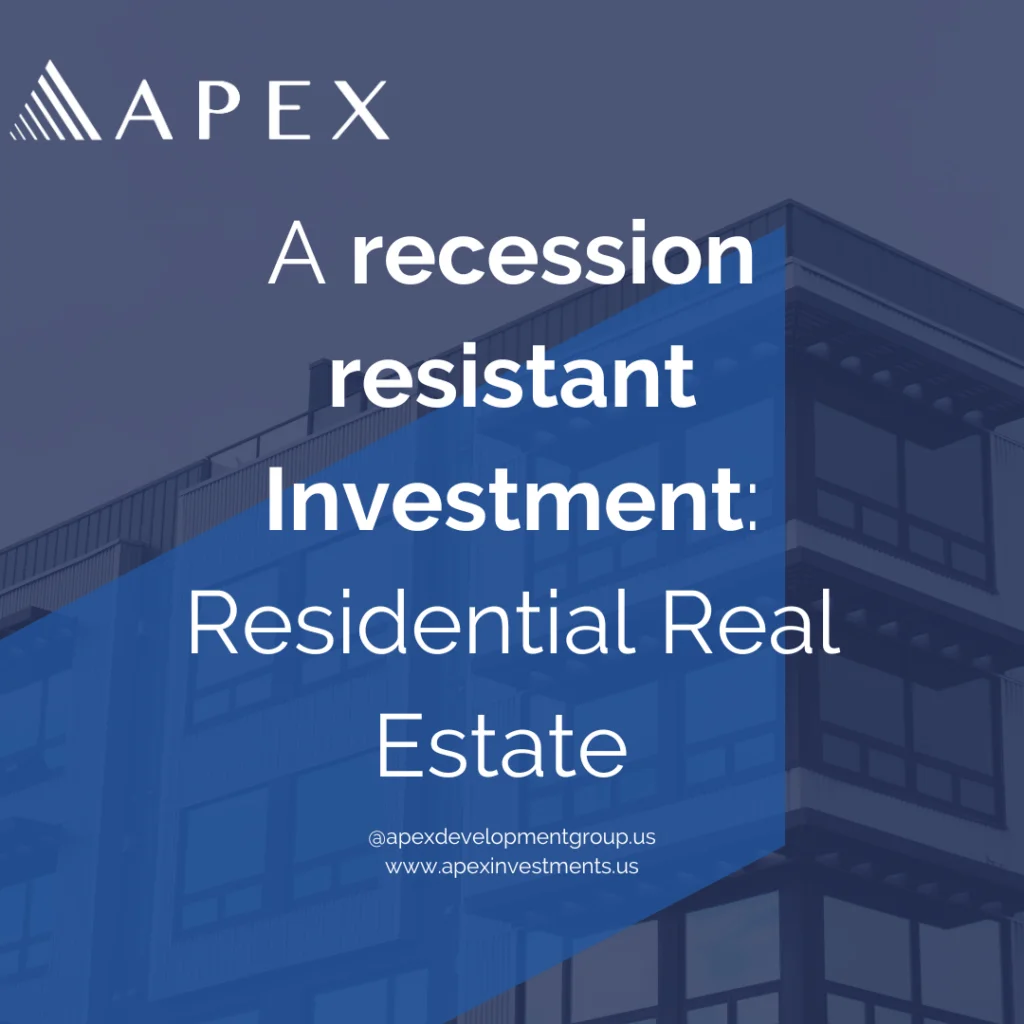
Home A Recession Resistant Investment, Residential Real Estate Blog · September 17, 2025 Why Residential Real Estate is a Strong Investment During Economic Crises Economic downturns and crises often bring uncertainty and volatility to financial markets. However, residential real estate has consistently proven to be a resilient and valuable asset class during such times, so called recession resistant investment. This article explores the reasons why investing in residential real estate can be a wise decision during economic crises, drawing on historical examples and key factors that contribute to its stability and growth. Resilience in Certain Markets One of the most compelling reasons to invest in residential real estate during economic crises is the resilience observed in certain housing markets. During the 2007-2009 global financial crisis, most financial assets experienced significant declines, others, like some real estate assets, managed to maintain or even increase property values. This resilience is often attributed to strong local economies, limited housing supply, and high demand. For instance, cities with diversified economies and robust job markets tend to fare better during downturns, as they attract a steady influx of residents seeking employment and stability. Investment Opportunities Economic crises can create unique opportunities for investors. Distressed sellers, facing financial difficulties, may be more willing to negotiate prices, providing opportunities to acquire properties at below-market rates. Additionally, lower mortgage rates, often implemented by central banks to stimulate the economy, can make financing more attractive. This was evident during the COVID-19 pandemic, where despite initial uncertainty, many investors capitalized on lower prices and favorable financing conditions. By purchasing properties during a downturn, investors can position themselves for significant gains when the market recovers. Long-term Growth Historically, real estate has been a stable long-term investment. Even after significant downturns, property values tend to recover and grow over time. This long-term growth is driven by factors such as population growth, urbanization, and increasing demand for housing. For example, after the 2007-2009 financial crisis, many housing markets not only recovered but also experienced substantial appreciation in property values. This trend underscores the importance of a long-term perspective when investing in residential real estate, as short-term fluctuations are often outweighed by long-term gains. Diversification Benefits Diversification is a key strategy for managing risk during economic uncertainty. While stock markets can be highly volatile during crises, real estate often provides a more stable investment option. This stability is particularly evident in markets less affected by the downturn. By diversifying their investment portfolios to include residential real estate, investors can mitigate the impact of market volatility and reduce overall risk. Real estate investments in the rental axis also offer the potential for rental income, providing a steady cash flow even during economic downturns. Government Interventions During economic crises, government interventions play a crucial role in stabilizing the housing market and supporting property values. Measures such as stimulus packages, mortgage relief programs, and interest rate cuts can help mitigate the impact of a downturn on the real estate market. For instance, during the COVID-19 pandemic, many governments implemented policies to support homeowners and renters, preventing widespread foreclosures and evictions. These interventions not only provide immediate relief but also contribute to the long-term stability of the housing market. Be Prepared: Invest Before the Crisis Hits While economic downturns and crises pose challenges, they also present opportunities for investors willing to navigate the uncertainties. Residential real estate has consistently proven to be a resilient and valuable asset class during such times, offering long-term growth, diversification benefits, and opportunities for strategic investments. By understanding the factors that contribute to the stability and growth of the housing market, investors can make informed decisions and capitalize on the potential of residential real estate during economic crises. At Apex, we specialize in joining forces with our investors to navigate the complexities of the real estate market. Our expertise and tailored investment strategies ensure that everyone is well-prepared to make informed decisions and seize opportunities, even in uncertain times. Don’t wait for the next crisis to strike—start building your resilient real estate portfolio today and secure your financial future. Mitigating Risks in Real Estate Investments: A Professional Approach While real estate often proves to be a resilient investment during economic downturns, it’s essential to implement strategies that can further mitigate risks. Here are some proven approaches: Refinancing for Optimal Cash Flow: Interest Rate Arbitrage: By refinancing at a lower interest rate, you reduce your monthly mortgage payments, freeing up cash flow to cover other expenses, reinvest in your portfolio or distribute to investors. This can be especially beneficial during economic downturns when income may be reduced. Debt Structure Optimization: Renegotiate the terms of the current loan agreement aiming to provide some financial relief in the short term or gaining some flexibility to perform the initial business plan. Maximizing Property Income: Pricing Optimization: Ensuring that your rental rates are competitive helps to maintain occupancy rates and avoid vacancies, which can be a significant financial burden during a downturn. Increase other income streams: Offering additional services can increase income and attract higher-quality tenants, improving the overall financial performance of your property. Cost Reduction: By implementing cost-saving measures, you can increase your property’s profitability. Identifying Market Opportunities: Distressed Properties: Investing in distressed residential properties can offer significant value potential, as they are often priced below market value. However, it’s important to conduct thorough due diligence to assess the underlying condition of the property and potential risks. Emerging Neighborhoods: Identify neighborhoods that are experiencing growth or revitalization. These areas often offer more affordable housing options with potential for appreciation. Portfolio Optimization Location Analysis: Focusing on properties in high-demand areas with favorable economic conditions can help to mitigate the risk of property value decline during a downturn. Selective Acquisitions: Carefully selecting properties that align with your investment goals and offer long-term growth potential can help to diversify your portfolio and reduce your exposure to market risk. By partnering with experienced real estate professionals who employ proactive strategies focused on risk management, you can position your residential real estate investments to weather
Demographics & Lifestyle Shifts

Home Demographics & Lifestyle Shifts Blog · July 25, 2024 The New Housing Market Landscape The real estate market is evolving as demographics and lifestyle shifts are shaping a dynamic real estate landscape. As a savvy investor, understanding these trends is crucial to identifying and capitalizing on promising opportunities. This article explores the enduring appeal of housing investments and highlights the demographic shifts and lifestyle preferences driving a boom in both multifamily and single-family properties. Why Housing Remains a Top Investment Choice: When considering commercial real estate investments, both multifamily and single-family properties offer distinct advantages. Multifamily has traditionally held the larger share of the market, providing consistent cash flow and stable returns with lower volatility compared to other sectors. This stability is key during economic downturns, where multifamily investments tend to experience smaller fluctuations in value. Single-family homes, on the other hand, can offer potentially higher returns due to their appreciation potential, particularly in appreciating markets. They also provide greater control over the property and potentially lower management complexities. Ultimately, the best investment choice depends on your individual risk tolerance and financial goals. Let’s delve into some key benefits of housing investing and explore the reason to navigate this dynamic environment. Reliable Cash Flow: Housing offers a powerful combination of steady rental income and lower vacancy rates compared to other commercial sectors. This is because people always need a place to live, regardless of economic conditions. This consistent demand fuels high returns for investors. Landlords can maintain occupancy rates and charge competitive rents, resulting in a reliable stream of cash flow. Data-Driven Returns: Studies by organizations like the National Council of Real Estate Investment Fiduciaries (NCREIF) show that multifamily investments have historically delivered strong average annual returns, outperforming other commercial sectors like office or retail, which can be more volatile and offer lower average returns. Lower Risk: Compared to other commercial real estate sectors, multifamily investments experience less dramatic swings in value during economic downturns. This is because housing is a basic need, and vacancy rates tend to be more manageable. Businesses, on the other hand, may downsize or relocate during economic hardship, impacting office and retail spaces more significantly. Hedge Against Inflation: Rents can be adjusted over time to keep pace with inflation, which helps to preserve the purchasing power of an investor’s returns. This makes multifamily a good hedge against inflation, unlike fixed-income investments like bonds. Diversification Powerhouse: Spread risk by investing in different locations, with varying unit sizes and price points, across both multifamily and single-family options. Appreciation Potential: Well-maintained properties are strong candidates for long-term capital gains due to appreciation in value. Several factors contribute to this growth, including population growth, limited land availability in desirable locations, and the overall rise in housing costs. Additionally, proactive management strategies like renovations, upgrades, and improved amenities can further enhance your property’s value beyond market appreciation. This “forced appreciation” translates to a higher overall return on investment. Active Management Advantage: Proactive management strategies like renovations, rent adjustments, and efficient operations can enhance returns for both multifamily and single-family properties. Tax Benefits: Depreciation and tax-deductible expenses further improve your overall returns. Current Market Trends Fueling Growth: Current demographic and lifestyle trends are converging with the established advantages of housing investment, creating an exceptional opportunity for investors. This “perfect storm” presents a chance to capture a larger share of the housing market than ever before, with strong potential returns across both multifamily and single-family properties. Here is why: Shifting Preferences, Growing Demand: Millennials, now the largest generation in the U.S. workforce, prioritize flexibility and experiences over traditional homeownership. This, coupled with Gen Z’s similar outlook, fuels a significant demand for rentals offering space, amenities, and freedom from long-term commitment. To capitalize on this trend, consider investing in mixed-use developments or apartment buildings in walkable, amenity-rich communities close to job centers. These areas cater perfectly to the preferences of this dominant demographic. Remote Work Revolution: The rise of remote work allows people to live in desirable locations without being tied to a specific job market, increasing demand for rentals in these areas. Also, as the pandemic has normalized remote work, impacting how people utilize their living spaces. Homes with dedicated office areas, high-speed internet access, and co-working spaces are becoming increasingly desirable. Investors can consider renovations or upgrades on existing properties to cater to this growing demand. Empty Nester Movement: Older adults seeking a more manageable living space create a demand for single-family rentals that offer more space and privacy than apartments while still being cost-efficient compared to owning a large house. Urban Flight: Rising costs and congestion in major cities are pushing people towards suburbs, increasing demand for rentals in those areas. Family Formation: Young families often prioritize space for children, with rentals providing a solution for those not yet ready to buy. Migration Patterns: While major cities still hold appeal, a noticeable trend is the migration of residents to suburbs and smaller metropolitan areas. This shift reflects a desire for more space, affordability, and a stronger sense of community. Investors can capitalize by focusing on multi-family and single-family properties in these emerging suburban hotspots. The Rise of the Sun Belt: Sun Belt cities in the southern and southwestern United States are experiencing a population boom driven by factors like favorable weather, affordable living costs, and a growing job market. This surge in demand is creating a strong rental market for investors to consider. Navigating these dynamic trends requires a deep understanding of local markets and expert investment guidance. At APEX, we leverage our extensive experience and data-driven approach to identify the most promising real estate opportunities aligned with evolving demographics and lifestyle preferences. We offer a comprehensive suite of investment solutions and empower you to capitalize on the real estate market. Research local market trends, understand the specific management considerations of different property types and conducting thorough due diligence is crucial to invest wisely invest in Real Estate. Contact APEX today to discuss your investment goals and explore how we
Unlocking Value Through Refinancing
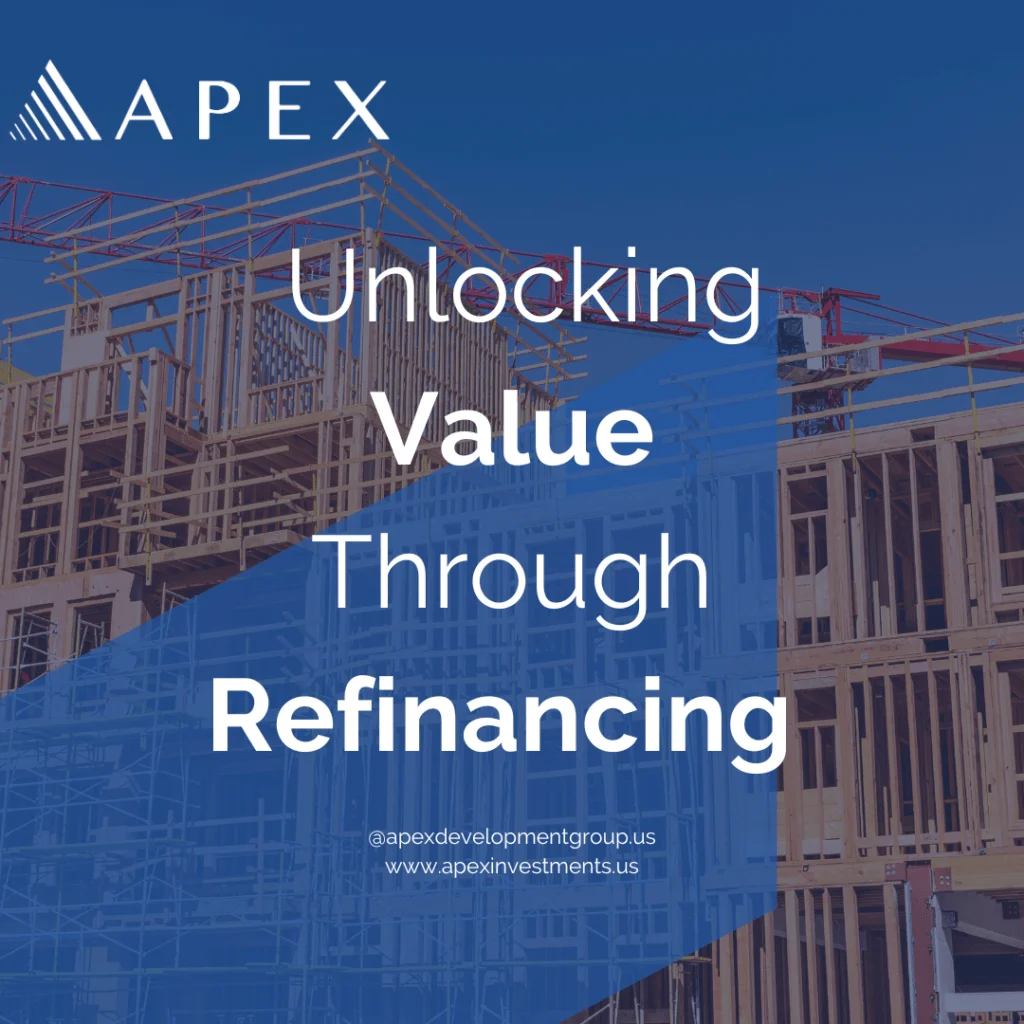
Home Unlocking Value Through Refinancing Blog · June 27, 2024 A Post-Stabilization Strategy Reaching stabilization is a pivotal moment in the life cycle of a real estate investment. Unlocking value through refinancing signifies a property has achieved a sustainable level of occupancy and income, marking a transition from the initial lease-up phase to a period of stable operations and predictable cash flow. This milestone often prompts investors to consider the optimal long-term financing strategy. Refinancing as a Strategic Tool: Refinancing a property can be a powerful tool for unlocking additional capital and increasing long-term returns. Ideally, refinancing should generate additional proceeds that exceed the cost difference between the original and new loan. This surplus can be used for a capital return for investors, essentially returning a portion of their initial investment. However, achieving successful refinancing requires meeting specific criteria and implementing strategic actions beforehand. Financing Strategies for Stabilized Properties: In the case of value-add investments, where bridge loans are commonly used to finance renovations and improvements, stabilization presents an opportunity to explore more permanent and cost-effective financing options. This typically involves seeking a permanent loan, often from government-sponsored enterprises (GSEs) like Fannie Mae or Freddie Mac. These loans offer attractive terms, including lower interest rates and longer maturities, compared to bridge loans. However, it’s important to note that not all properties require bridge loan financing during the initial acquisition phase. Some investors may directly acquire a property with an agency loan, which can also be a viable option. Regardless of the initial financing structure, the key takeaway is that once a property reaches stabilization, investors should prioritize securing more efficient and cost-effective long-term financing. This often translates to replacing bridge loans with permanent agency loans. Strategies for Properties Already Financed with Agency Loans: For properties already financed with agency loans, alternative strategies like refinancing or supplemental loans from Freddie Mac or Fannie Mae can be explored, depending on the prevailing market conditions. By carefully navigating the post-stabilization landscape and actively seeking optimal financing solutions, investors can maximize the profitability and long-term value of their real estate holdings. Requirements for Refinancing: High Occupancy: Lenders typically require a high occupancy rate, often exceeding 90%, to ensure consistent rental income for debt service. Strong (DSCR): Your property’s DSCR, which measures its ability to cover debt obligations, needs to be above a certain threshold, usually greater than 1.25x. This demonstrates a healthy cash flow for the property. Optimal Cost Structure and Revenue Generation: Lenders favor properties with efficient operating expenses and strong revenue generation. This ensures the property can support the refinanced loan while delivering positive cash flow. Strategies for Achieving Optimal Refinancing: Lease-Up Strategies: Implement targeted marketing and leasing strategies to achieve and maintain high occupancy levels. This could involve offering incentives, optimizing rental rates, and actively managing the leasing process. Market-Driven Pricing: Conduct a thorough market analysis to determine optimal rental rates based on the current supply and demand for similar units in the area. This pricing strategy helps maintain high occupancy while maximizing revenue. Aggressive Cost Control: Implement proactive measures to control operating expenses. This might involve renegotiating vendor contracts, identifying cost-saving opportunities, and optimizing property management practices. Data-Driven Decisions: Leverage data analytics to understand market trends, tenant demographics, and local factors. This knowledge enables data-driven decision-making that aligns with requirements for successful refinancing. Leveraging Strategies with Vendors: Explore partnerships and agreements with vendors that optimize cash flow. Consider negotiating extended payment terms, bulk discounts, or other arrangements that benefit both parties. Building a Robust Lender Network: Cultivate relationships with a variety of lenders. This expands your options and allows you to negotiate the best possible terms and rates based on your property’s performance and current market conditions. Reaching stabilization signifies a property’s transition from initial lease-up to a period of stable operations and predictable cash flow. This milestone presents a crucial opportunity for investors to unlock further value through strategic refinancing. By meeting the outlined requirements and implementing the recommended strategies, refinancing can deliver significant benefits for a property’s long-term performance: Increased Long-Term ReturnsRefinancing offers the opportunity to secure lower interest rates and longer loan terms, leading to substantial cost savings over time. Additionally, successful refinancing can generate a capital return for investors, boosting overall profitability. Enhanced Cash FlowThrough strategically optimizing operating expenses and maximizing rental income, a property’s financial health is solidified. Refinancing with lower interest rates further improves cash flow, allowing for reinvestment in the property or the pursuit of new opportunities. Improved Financial FlexibilityReplacing a bridge loan with a permanent loan provides greater financial stability and long-term predictability. Additionally, refinancing may free up capital that can be used for further value-add improvements, acquisitions, or debt reduction across an investment portfolio. In conclusion, navigating the post-stabilization landscape with strategic refinancing empowers investors to unlock the full potential of their real estate holdings. By proactively managing a property’s financial health and capitalizing on favorable market conditions, investors can maximize long-term returns and achieve their investment goals. Previous PostMultifamily Sponsors: Attract Institutional CapitalNext PostDemographics & Lifestyle Shifts
Multifamily Sponsors: Attract Institutional Capital

Home Multifamily Sponsors: Attract Institutional Capital Blog · May 14, 2024 For multifamily sponsors seeking to elevate their investment game, securing capital from institutional investors can be a game-changer. Institutional investors bring not only significant financial resources but also expertise and a long-term perspective. But what exactly are institutional investors looking for in a sponsor? Our company, a multifamily sponsor at this moment specializing in the middle market and value-add opportunities, leverages extensive experience to provide insights into attracting institutional capital. This article explores key considerations for sponsors based on real-world scenarios. What Institutional Investors Seek in a Multifamily Sponsor Institutional investors are strategic partners, so they go beyond just the property itself. Here’s a breakdown of the key factors they consider: 1. Investment Structure: Single, Sizeable Check: Institutional investors prefer to invest large sums in a single transaction. Joint Ventures & Programmatic Approach: Building a long-term relationship with a sponsor offering a consistent pipeline of deals is highly attractive. 2. Property Characteristics (Middle Market Focus): Unit Count: It typically ranges from 100 units (the minimum for on-site management) to 250 units for middle-market investors. Location: Urban or suburban (with a recent trend towards suburbs due to remote work). Good traffic flow and strong lease-up potential are crucial. Vintage: While preferences vary, properties built since the 1980s are gaining traction. Newer properties are generally favored by larger institutions. Regardless of age, the property should be “institutional grade”. This means meeting specific quality standards, like having high ceilings and being a well-defined, single community with a clear identity, among others. Demographics: Strong demographics in the target area ensure a healthy pipeline of tenants, which is crucial for achieving high occupancy rates and low delinquency on rent payments. This, in turn, ensures a steady stream of rental income and other revenue streams, supporting the overall investment thesis. Ideally, the demographic mix within the target area should be diverse, with solid household income levels and the potential for future growth in both income and population. Market Dynamics: While the term “market dynamics” may seem broad, for institutional investors in the multifamily market, it boils down to finding the sweet spot between supply and demand. This is particularly crucial when considering locations outside of urban areas. Here, investors will meticulously analyze existing competition and the potential for future rent growth. Urban areas, by nature, tend to be more dynamic, offering a wider range of possibilities. However, venturing too far out can be a dealbreaker. Without sufficient demand to support the property’s value and future rent increases, the investment becomes less attractive to institutions. 3. Financial Performance: Financials naturally stand as a top priority for institutional investors. Cash flow expectations may vary, but some level of steady return is generally sought, especially for value-add projects where renovations will unlock the property’s full potential. Beyond cash flow, investors meticulously examine key metrics: initial cap rate, projected post-renovation rents, and achievable rent growth. Additionally, they prioritize a clear path towards a profitable exit strategy, emphasizing conservative assumptions about future market fluctuations. Cash Flow: Cash flow expectations for multifamily investments can vary. Opportunistic investors might be comfortable with properties that don’t generate immediate cash flow, prioritizing other factors like long-term appreciation, tax benefits, among others. However, most institutional investors in this market seek a level of “cash-on-cash” return, ensuring a steady income stream alongside the property’s potential for future growth. Metrics: Institutional investors delve into key financial metrics to assess the property’s investment potential. The initial cap rate, reflecting the property’s return on investment at acquisition, is a crucial starting point. They then analyze projected rent increases after any value-add renovations, ensuring these projections are grounded in realistic market trends. Additionally, they consider how efficient operations can lead to “cap rate expansion,” signifying an increase in the property’s value over time due to improved performance. Stabilized Yield: A positive “stabilized yield” is the target. This metric represents the return on investment after the property reaches full occupancy and rental income stabilizes. While a target range of 7-8% is common, achieving a higher yield depends on specific market conditions. Exit Strategy: A conservative approach to exit cap rate assumptions is crucial. This means the anticipated return on investment shouldn’t be heavily reliant on a projected decrease (compression) in market cap rates. Instead, the focus remains on the property’s core strengths, such as generating consistent cash flow and achieving realistic rent growth, to deliver a solid return for investors. 4. Operational Considerations: While securing the right property and crafting sound financial projections remain foundational in the multifamily market, institutional investors increasingly seek partners who excel in the operational aspects of real estate investment. Here’s how Apex brings these competitive advantages to the table: Vertical Integration: A strategic degree of vertical integration, where Apex manages functions like asset management, construction, and renovations in-house, offers distinct advantages. It fosters greater control over day-to-day operations, potentially leading to cost efficiencies and faster decision-making on repairs or upgrades. However, this approach requires a team with deep expertise to effectively manage these diverse functions. Apex has demonstrably built such a team, ensuring seamless execution and value creation. “Boots on The Ground” approach: Institutional investors seek sponsors with a deep understanding of local markets. This firsthand experience goes beyond simply knowing market trends; it’s about understanding the unique character and dynamics of each location. At Apex, we firmly believe in the power of the “boots on the ground” approach. Our market experts are deeply familiar with the specific neighborhood dynamics and regional tenant preferences. This deep understanding allows us to identify and source off-market deals, navigate local nuances, and make informed decisions that ultimately lead to stronger returns for our investors. Networking: Access to capital is critical for any multifamily project. Apex has cultivated strong relationships with multiple financing sources, brokers, and other key partners. This demonstrates not only our creditworthiness but also our ability to negotiate favorable terms. Our network of strategic allies allows us to secure the best possible options for each specific investment, maximizing value for all parties involved. Consolidated Team: Building a
How to determine if a property is a good long-term investment?

Home How to determine if a property is a good long-term investment? Blog · February 16, 2024 Building long-term wealth through multifamily real estate can be rewarding, but navigating this intricate landscape requires careful consideration of factors that impact property performance and profitability. This is where meticulous analysis becomes key for investors exploring potential acquisitions and how to determine if a property is a good long-term investment. A comprehensive assessment encompassing financial analysis, insightful market evaluation, and in-depth property assessment helps to ensure you’re making informed decisions. Evaluating a multifamily property as a long-term investment involves dissecting several key areas that reveal its potential for lasting success. We’ll analyze these three pillars: cash flow generation, market dynamics, and property condition. Cash Flow Generation At the heart of any successful multifamily investment lies its ability to generate consistent and positive cash flow. This refers to the net income your property produces after subtracting all operating expenses. Robust cash flow allows you to meet your financial obligations, reinvest in the property, and ultimately enjoy a healthy return on your investment. Several factors contribute to strong cash flow: Rental Income: Competitive rental rates, low vacancy rates, and efficient collection practices are crucial. Understanding the local rental market, tenant demographics, and potential rent growth opportunities is essential. Operating Expenses: It involves all operational costs, including property management, maintenance, taxes, and insurance. Minimizing costs through effective property management, smart vendor selection, and preventative maintenance practices significantly impacts profitability. Capital Expenditures: Budgeting for future expenses like roof replacements, appliance upgrades, and common area renovations ensures sustainable cash flow in the long run. Analyzing historical financial statements, projected income and expenses, and comparable properties helps assess a property’s current and future cash flow potential. Additionally, consider these key metrics: Capitalization Rate (Cap Rate): This metric represents the expected annual return on your investment based solely on the property’s net operating income (NOI). A higher Cap Rate generally indicates a higher potential return, but it’s crucial to consider the underlying factors like market risk and property condition. Debt Service Coverage Ratio (DSCR): This ratio measures a property’s ability to cover its debt service (mortgage payments and interest) with its NOI. A DSCR of 1.25 or higher is typically considered desirable, indicating enough cash flow to comfortably meet debt obligations. By analyzing these metrics alongside traditional cash flow analysis, you can gain a more comprehensive understanding of a property’s financial health and potential profitability. Market Dynamics When it comes to multifamily real estate, the property itself is just one piece of the puzzle. Ignoring market dynamics is like building a house on an unstable foundation. Understanding the surrounding environment – the neighborhood, the competition, the economic forces at play – is crucial for making informed, long-term investment decisions. Here’s what to consider: Location and demographics: Analyze neighborhood demographics, employment trends, rental demand, and overall desirability for tenants. Investors should look for properties in areas with strong population growth, job growth, and economic stability. Supply and Demand: Evaluate the current and projected availability of multifamily units compared to rental demand in the area. A healthy balance between available rental units and renter demand translates to stable occupancy rates and potentially higher rental rates. Track vacancy rates, absorption trends, and new construction activity. Comparable Properties: Research similar properties to compare market rents, cap rates, and vacancy rates. Gain valuable insights into market performance and potential returns. Economic Factors: Consider local and national economic trends that could impact the rental market and property value. Stay informed to mitigate risks and maximize opportunities. Regulations and Zoning: Understand potential development and rental restrictions imposed by local zoning and regulations. Anticipate changes that might affect your investment strategy. Amenities: Analyze access to public transportation, major highways, and desirable amenities like parks, shopping centers, and top-rated schools. These factors attract and retain tenants, driving higher rents and lower vacancy rates. By thoroughly understanding market dynamics, you can identify properties positioned for success within a thriving ecosystem. Property Condition While financial analysis is crucial, overlooking a property’s physical condition in multifamily investing can be akin to ignoring its very foundation. Ignoring potential repairs, outdated systems, or non-compliance issues can lead to unforeseen expenses, tenant dissatisfaction, and even legal challenges. A thorough analysis, encompassing age, construction quality, unit mix, amenities, and regulatory compliance, paints a clear picture of the property’s long-term potential and helps ensure your investment rests on a solid foundation for sustainable success. Investors should look for properties that are well-maintained and require minimal repairs or upgrades. A thorough property assessment should encompass: Physical Condition: Assess the building’s age, construction quality, required repairs, and potential for capital improvements. Unit Mix: Evaluate the variety of unit sizes and types to understand their appeal to different demographics and rental potential. Amenities: Consider available amenities such as parking, laundry facilities, fitness centers, and their value to tenants compared to competitors. Compliance with Regulations: Verify compliance with all building codes, zoning regulations, and safety standards to avoid future issues. Maintenance Review: Review past maintenance records to understand recurring costs and potential future needs. Energy Efficiency: Analyze the property’s energy efficiency and potential for upgrades to reduce operating costs. Investing in a well-maintained property with the potential for further value improvements through strategic renovations can set you on the path to long-term financial success. Other Considerations: Finally, investors should consider their financing options when evaluating a property’s long-term investment potential. This means looking for properties with favorable financing terms and low interest rates, as this can help to maximize returns over time. Conclusion: While thorough analysis and due diligence are crucial for identifying promising multifamily investments, navigating the intricate details often demands specialized expertise, knowledge, and dedicated resources. The complexities can be overwhelming for individual investors. This is where experienced multifamily sponsors step in, offering their in-depth knowledge and acting as trusted partners for your journey. By partnering with the right sponsor, you gain access to the expertise required to analyze cash flow, market dynamics, and property condition effectively. This not only saves you valuable time and resources but also ensures you leverage insights based on extensive market experience.
Regulation D type of investors
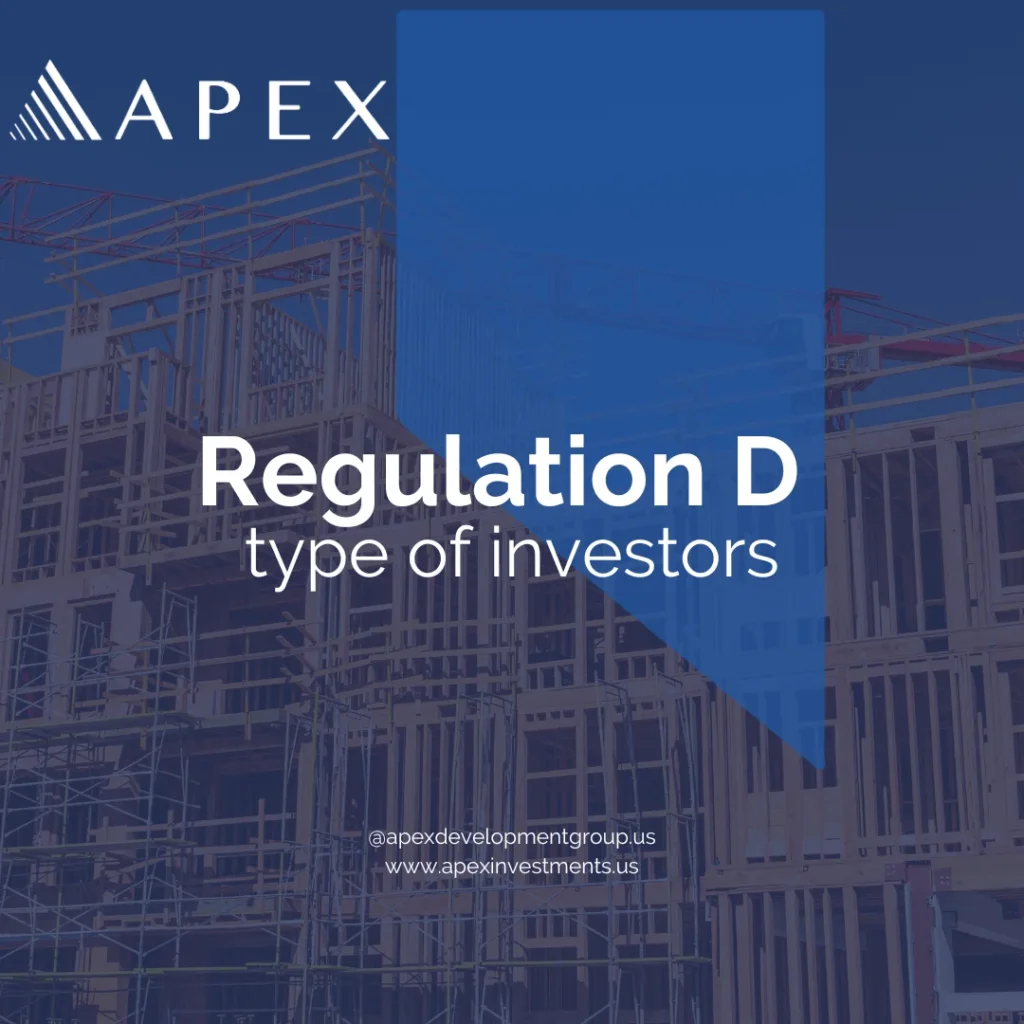
Home Regulation D type of investors Blog · January 19, 2024 While Regulation D empowers companies to attract capital through Rule 506(b) and 506(c) exemptions, simply demonstrating the necessary investment capital doesn’t guarantee an investor’s entry into the SPV). Type of investors becomes a crucial factor, as only accredited or non accredited, but sophisticated, individuals meeting the SEC’s stringent income or net worth requirements are eligible to participate. Accredited investors There are two profiles that can qualify as an accredited investor, it can be a “retail” investor (natural person) or an institutional company. Each of these figures must fit some criteria: Accredited Retail Investor For being an accredited retail investor, the person must fit in one of these conditions: Have an individual net worth or joint net worth with their spouse (or spousal equivalent) that exceeds $1M. Being a Natural person who individually earned $200,000 dollars in each of the two most recent years, or jointly with their spouse, earned over $300,000 in each of those years. Natural persons with Series 7, 65 or 82 securities licenses*. A director, executive officer, or general partner of the company selling the securities. A “knowledgeable employee” which has a wide definition of a private fund. *more info: https://www.sec.gov/corpfin/amendments-accredited-investor-definition-secg Accredited Institutional investor To qualify as an accredited institutional investor, one of these criteria must be fitted: Any Bank, insurance company, registered investment company, business development company or small business investment company, SEC and state-registered investment advisers, exempt reporting advisers, and any rural business investment companies (RBICs). An employee benefit plan qualifies if investment decisions are made by a bank, insurance company, or registered investment adviser. Alternatively, the plan is eligible if it possesses total assets exceeding $5M. A charitable organization, corporation, or partnership with assets exceeding $5M. A business in which all the equity owners are accredited investors. Businesses, including Indian tribes, governmental bodies, funds, and entities organized under foreign laws, with assets surpassing five million dollars and owning investments exceeding $5M and that was not formed for the specific purpose of investing in the securities offered. A trust with assets in excess of $5M. A “Family office” with at least $5M in assets under management. Non-Accredited Investor Not all entities, whether business or legal, qualify as accredited investors. Those who fall outside this defined category must undergo qualification as non-accredited investors. However, mere financial resources are not sufficient for non-accredited investor status. The individual or entity must demonstrate characteristics indicative of a sophisticated investor. This requirement applies in the following situations: The person has such knowledge and experience in financial matters that they can evaluate the merits and risks of an investment in the company. Has a professional advisor with knowledge and experience that has reviewed the Offering Package and has approved an investment based on his/her professional experience. In conclusion, understanding the intricacies of Regulation D and the classifications of investors under Rule 506 (b) and 506 (c) is vital for companies seeking to raise capital. Accredited investors, whether retail or institutional, play a crucial role in these fundraising ventures, meeting specific criteria that verify their financial capability and sophistication. Non-accredited investors, while not meeting the stringent criteria of accredited status, can still participate if deemed sophisticated, supported by a level of knowledge and experience, or guided by a professional advisor. By navigating these regulatory frameworks and delineating investor categories, companies can foster transparency, compliance, and trust in their fundraising efforts. It is essential for all stakeholders to be informed in the regulatory landscape to facilitate a seamless and legally sound capital-raising process. As market dynamics evolve, staying informed about updates to Regulation D and related definitions is imperative. Companies should remain vigilant in adapting to regulatory changes and seek professional guidance to ensure continued compliance. Previous PostStrategic Supply Chain ManagementNext PostHow to determine if a property is a good long-term investment?
Strategic Supply Chain Management
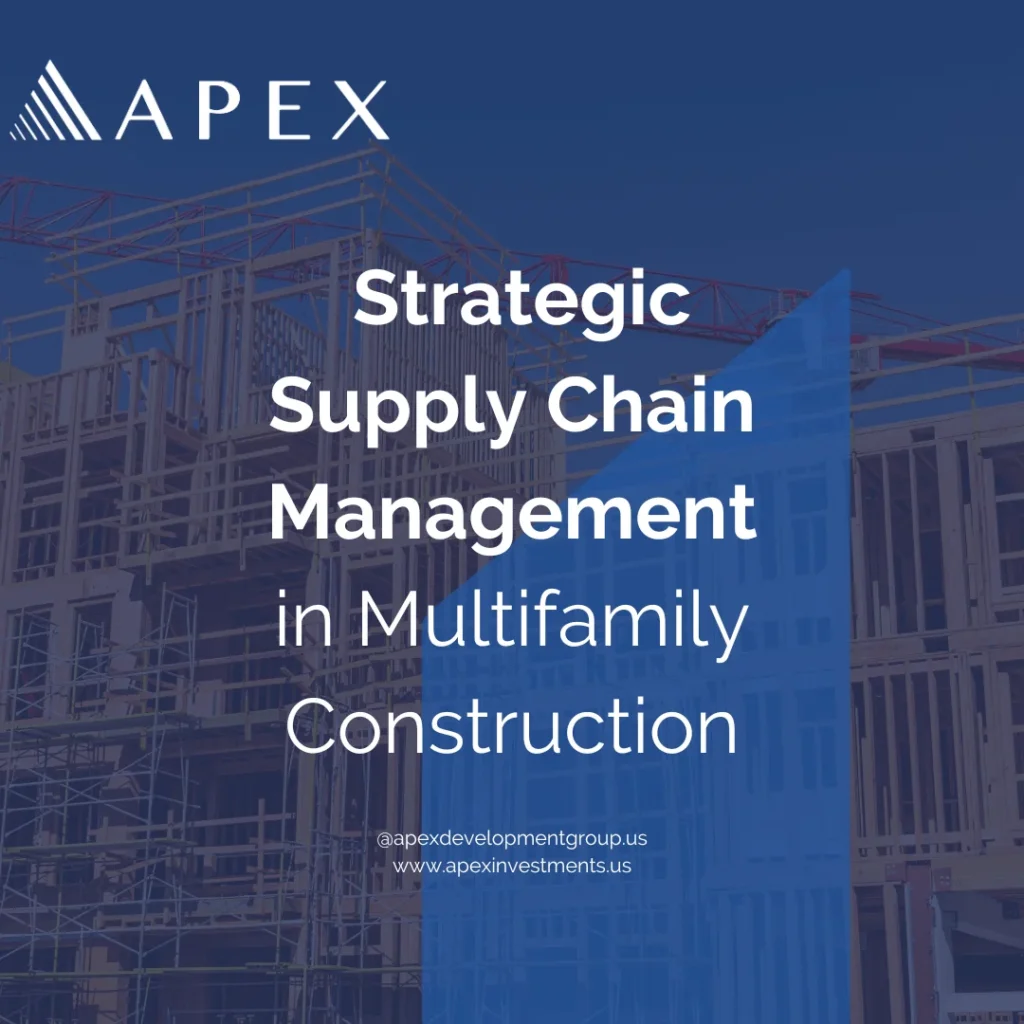
Home Strategic Supply Chain Management Blog · November 27, 2023 Multifamily Construction through Strategic Supply Chain Management In the dynamic world of multifamily real estate, where timely project completion and client satisfaction are paramount, having a strategic supply chain management has emerged as a game-changer. Embracing efficient and well-structured supply chain solutions has become the cornerstone of success for real estate firms seeking to deliver exceptional results and outpace their competitors. By streamlining supply chain processes, multifamily General Partners (GPs) can effectively navigate the intricate maze of procurement, logistics, and distribution, ensuring that their projects remain on track, within budget, and meet the highest standards of quality. A well-optimized supply chain not only minimizes delays and disruptions but also empowers real estate firms to enhance resource allocation, leading to cost savings and increased profitability. Accelerating response times and fostering seamless planning and coordination enable companies to effectively address market fluctuations and adapt to changing consumer demands with greater agility. These improvements, in turn, contribute to higher client satisfaction, establishing a remarkable competitive advantage for real estate enterprises in a market where excellence is the benchmark. At the heart of successful supply chain management lies a strategic approach to logistics, the set of activities aimed at efficiently supplying the necessary resources for optimal project execution. The supply chain plays a pivotal role, not only as a contributing factor but as an indispensable requirement for ensuring sound logistics practices in multifamily construction. Supply, provision, and procurement in this context entail the proactive provision of essential resources to various project facets. Identifying resource requirements can occur during the planning phase or directly on-site, underscoring the importance of anticipating needs, recognizing priorities, and optimizing resource management. This proactive approach constitutes what can be termed as a “planned purchase,” an essential element in the multifaceted world of supply chain management within the multifamily real estate sector. Effective supply chain management (SCM) emerges as an essential practice, fostering enhanced coordination and communication across all parties involved in the process. This intricate planning not only safeguards the quality and profitability of a project but also becomes a mechanism for significant outcomes. When SCM is expertly managed, it becomes a potent force for adding substantial value to the construction and renovation processes. This manifests in enhanced revenue streams, streamlined costs, and a positive flow effect on an asset’s overall performance. Conversely, poorly managed SCM can unleash a cascade of challenges, resulting in unforeseen expenses that can significantly impact the financial health of the multifamily real estate project. Apex’s Approach to Supply Chain Efficiency At Apex, we are always one step ahead when it comes to developing material logistics. It is important to have the implements used during unit renovations on time, to avoid delays, setbacks, and extra costs. We are committed to developing the most efficient and effective process possible. We use a variety of strategies to achieve this goal, including: Developing strong relationships with suppliers. One of the most important ways to improve supply chain efficiency is to develop strong relationships with suppliers. By working closely with them, we can gain access to better prices, quality, and delivery terms. Additionally, strong supplier relationships can help to reduce supply chain disruptions and ensure that companies have a reliable source of raw materials and components. We work closely with our suppliers to ensure that they understand our needs and can provide us with the products and services we need. Streamlining processes. Companies can also improve supply chain efficiency by streamlining their processes. This involves identifying and eliminating unnecessary steps in the supply chain, as well as standardizing processes across different business units. Streamlining processes can help to reduce costs, improve lead times, and reduce errors. We are constantly looking for ways to improve our processes and make them more efficient. Using data to make informed decisions. By collecting and analyzing data on supply chain performance, we can identify areas for improvement and make data-driven decisions about how to optimize our supply chain process. Collaborating with partners. We work with our suppliers, customers, and other partners to share information and develop innovative solutions. This can involve working with suppliers, customers, and other partners to share information and develop innovative solutions. Collaboration can help to break down barriers and create a more efficient and responsive supply chain. By implementing these strategies, we have been able to significantly improve our supply chain efficiency. This has allowed us to reduce costs, improve lead times, and reduce errors. We are committed to continuing to improve our supply chains and delivering the best possible results. Enhancing Efficiency through Material Management: A Case Study in Multifamily Renovations Problem/ Opportunity: A while ago, the company faced a challenge: the lack of visibility and control over material management. This led to several issues such as: Material Loss and Theft: Materials arriving at the renovation site often go unaccounted for, increasing the risk of loss or theft. Material Shortages: Without proper tracking, material shortages can disrupt the renovation process, causing delays and additional expenses. Inefficient Material Handling: Storing materials in containers instead of directly delivering them to the renovation units leads to inefficiencies and safety hazards. To address the challenges posed by ineffective material management, the supply chain team embraced a comprehensive approach that transformed the process into an opportunity for enhanced efficiency and cost savings. By implementing a dedicated material receiving role, conducting thorough material inspections, and implementing phase-based material reviews, the team seized the opportunity to minimize material loss, eliminate shortages, and streamline material handling. This proactive approach not only safeguarded project resources but also accelerated project completion times, bringing renovated units to market sooner and maximizing returns. Results: The implementation of these measures has significantly improved the efficiency and effectiveness of the renovation process: Reduced Material Loss and Theft: With dedicated oversight, material loss and theft have been minimized, ensuring project cost control. Eliminated Material Shortages: Proactive material tracking prevents shortages, preventing delays and additional material procurement costs. Enhanced Efficiency: Direct material delivery to renovation units streamlines
Developing Value-Add Renovations and Operational Efficiency
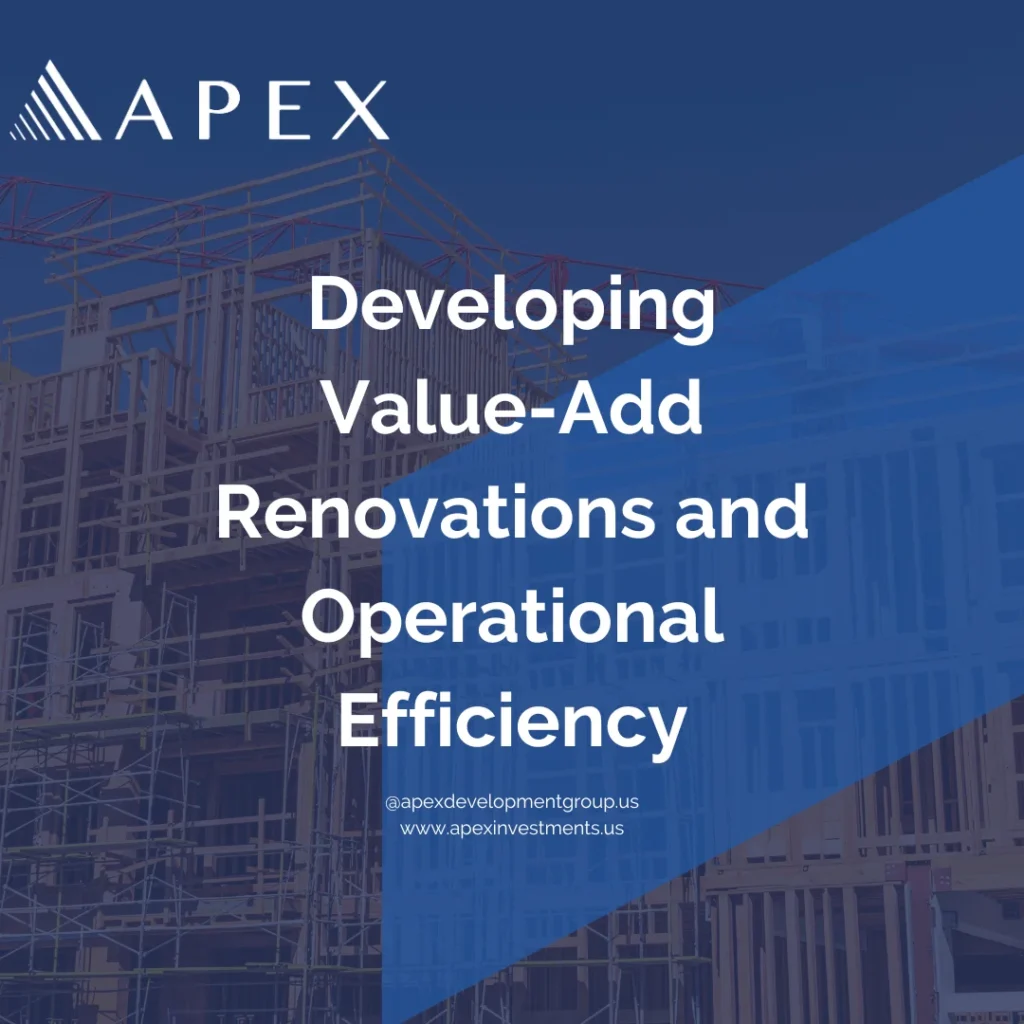
Home Developing Value-Add Renovations and Operational Efficiency Blog · November 14, 2023 Renovation is a key concept in real estate investment, especially for multifamily properties. Value-Add renovations involve making strategic modifications to units to align with market expectations, within specific budget and scope limitations. Renovations do not typically include extensive structural changes, but rather careful planning of smaller, yet significant, alterations. When delving into the process of renovation, a wide range of activities takes center stage. From the repainting of cabinets to the replacement of faucets, door handles, and appliances, every detail is carefully considered to uplift the overall look and feel of the property. Multifamily value-add investments, powered by renovations, generate a wide range of benefits. Not only increase rental income, but also boots the overall value of their property. Moreover, a well-executed renovation can create a sense of community pride, fostering a positive environment that cultivates long-term tenant satisfaction and retention, and can also help to reduce maintenance costs and extend the lifespan of the property. Choosing the Right Approach for Your Multifamily Property: Renovations vs Refurbishments Understanding the difference between renovation and refurbishment is crucial. While the notion of renovation predominantly turns around transforming spaces, elevating them to their full potential, the core of refurbishment lies in substantial structural modifications, as explained before, a renovation does not include significant alterations of the unit, such us a modification of the structure that would apply to refurbishment which in other words entails significant repairs, including pivotal movements such as the displacement of walls, reconfiguration of plumbing systems, and other intricate structural alterations. From an economic perspective, the magnitude of refurbishment translates to a notably higher cost compared to renovation, consequently presenting distinctive scopes of work for each process. Therefore, a unit that undergoes renovation generally costs much less in the market, highlighting the clear difference between these two approaches in the real estate world. This can also be seen in the investment strategies of value-add and opportunistic. While value-add method primarily focusses on strategic renovations aimed at enhancing the appeal and functionality of properties, the opportunistic approach delves into more substantial structural modifications, aligning closely with the concept of refurbishment. With value-add investments, the emphasis lies on cost-effective upgrades and targeted enhancements that elevate the overall market appeal of the property, thereby increasing its competitive edge. In contrast, opportunistic investments entail significant repairs and comprehensive structural alterations, often resulting in a higher investment cost due to the magnitude of the refurbishment process. Multifamily Value-Add Renovations: A Strategic Approach to Maximizing ROI Maximizing return on investment (ROI) through value-add renovations in multifamily properties requires a strategic approach that carefully considers cost-effective upgrades to enhance the property’s appeal and competitiveness in the current market. This involves understanding the target tenant demographics, identifying their preferences, and implementing improvements that tailor to their needs and aspirations. One of the most effective ways to increase the value of a multifamily property is by renovating individual units. In addition to unit renovations, the renovation team can also add value to a multifamily property by upgrading common areas and amenities, such as landscaping, fitness centers, pool area and outdoor living spaces. These desirable amenities can increase tenant satisfaction, leading to longer tenant retention and reduced turnover costs, which can boost investor returns. When implementing value-add renovations, it is important to be aware of two main factors: overcapitalization and budget overruns. Overcapitalization occurs when the cost of renovations exceeds the value added to the property, which can fade away ROI and make it difficult to exit the investment profitably, in other words, spending more on renovations than the property is worth can hurt your bottom line and make it harder to walk away from the investment. On the other hand, it is important to be conscious of the cost of renovations as it might lead to budget overruns and financial strain. That is why, it is therefore important to obtain accurate estimates from qualified contractors and to factor in contingency costs. Apex´s value-add strategy. At Apex, our commitment lies in amplifying the value of our assets through a comprehensive approach that encompasses the revitalization of both interior and exterior spaces, striving to deliver a product that aligns seamlessly with the ever-evolving demands of the market. Moreover, our dedication extends beyond the confines of indoor spaces, as we actively enhance the communal areas, fostering an enriched living experience for our tenants. To achieve this, we have assembled a dedicated and skilled team that collaborates closely with reliable contractors to ensure the delivery of a superior-quality product. Here at Apex, we make it a priority to collaborate with experienced companies and contractors that have a strong history in this field to ensure that all the construction work runs smoothly and efficiently. Renovations team on the field At Apex, we understand that the success of any multifamily renovation project depends on careful planning, coordination, and execution. That’s why we have two dedicated departments responsible for carrying out all operations and logistics related to the renovation plan for each property. The first department is responsible for everything related to supply chain and budgeting; the second department is responsible for everything related to coordination and execution of the renovation plan, product control, schedule, and budget. In general, for each project/property, we define a plan that allows us to calculate quantities and negotiate with our suppliers, seeking for efficiencies in logistics and budget. Also, we have also successfully established a subcontractor loyalty plan that ensures that our subcontractors execute our projects according to our quality and efficiency standards. During the operation of the asset, after the acquisition, the renovation team works very closely with the Asset Management department and the property management company to be harmoniously coordinated for the correct execution of the renovation plan. Here, our role is essential to ensure that we are meeting the product standards, regulations, and defined budget as the success of the project depends on it. At APEX, we have a strong commitment to quality and
Real Estate Investment Strategies: The Power of Value-Add
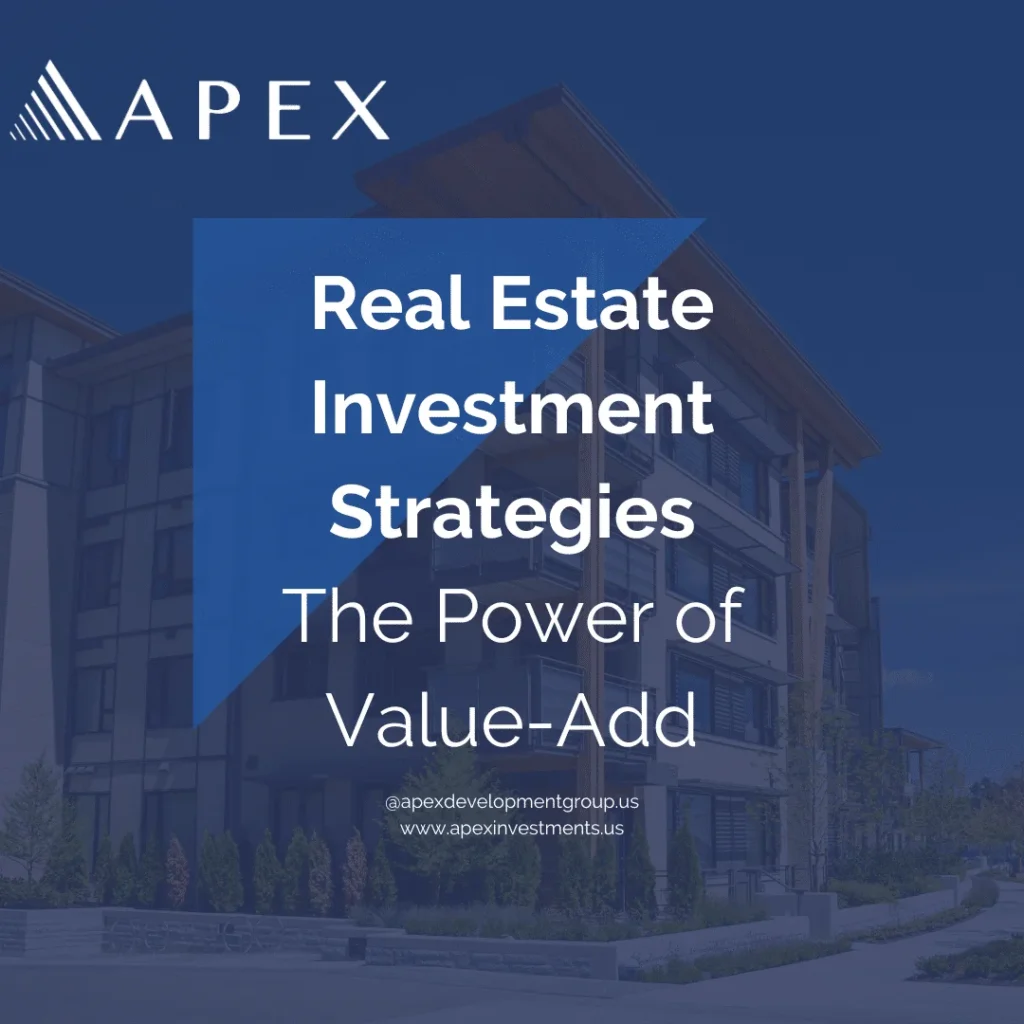
Home Real Estate Investment Strategies: The Power of Value-Add Blog · October 30, 2023 In the world of real estate investment, different strategies serve various investor goals and risk preferences, ranging from safer income-generating approaches to more aggressive tactics targeting higher returns. Four key real estate investment strategies, namely core plus, core, value add, and opportunistic, represent different levels of risk and potential returns. Understanding these strategies is essential for making informed investment decisions. Here is a brief overview of the four main investment strategies: Core: This strategy involves investing in stable, income-generating properties with low risk. These properties typically have long-term leases and require minimal operational intervention. Core Plus: Core plus investments encompass properties that have a stable income but may have some opportunities for improvement or increased cash flow. They usually involve moderate risk, slightly higher than core investments. Value Add: Value-add strategies involve acquiring properties that require improvements or restructuring to increase their value. These investments often involve renovations, rebranding, or operational enhancements to boost the property’s income potential. Opportunistic: This high-risk, high-reward strategy involves investments in properties that require significant improvement, repositioning, or redevelopment. These properties often come with high vacancy rates or substantial rehabilitation needs and require active management and a strategic exit plan to realize their full potential. Each strategy can be applied considering various variables in different projects, and it is the role of the project developer or structurer to intelligently and assertively define which strategy should be applied. Similarly, each investor can also adapt to each strategy according to their expectations. Therefore, it is important to have a better understanding of each one, with the aim of having sufficient information to make assertive decisions. Investing in real estate requires a deep understanding of the different investment strategies, each with its own risk-reward profile. For example, core plus and core investments imply acquiring properties with lighter renovations or those with relatively higher occupancy rates, prioritizing stable cash flows, assuming minimal intervention for steady operations. While these strategies offer stability, they may lack the dynamic leverage necessary for significant value creation. Also, value-add and opportunistic strategies require more professionalism due to the renovations team’s expertise and experience in managing complex projects, ensuring timely completion and cost-effectiveness. Here is where we find the value-add strategy as our perfect match. By actively engaging in property renovations and enhancements, the renovations team embraces the inherent challenge of improving properties to unlock their full income-generating potential. Recognizing the correlation between visible upgrades and increased rental value, we leverage our expertise in renovations and believe in the direct impact of tangible improvements on the overall net operating income (NOI) of the property. Apex’s projects team on the value-add strategy. From the beginning, Apex’s projects team demonstrates a proactive and comprehensive approach to the value-add strategy, making a significant impact on the success of their real estate approach. Their involvement begins before property acquisition, as they engage in meticulous due diligence assessing each property’s current state and crafting a strategic roadmap for transformation, which will eventually lead to rent bumps and higher NOIs. With a steady commitment to precision and efficiency, the team meticulously formulates budgets, schedules, and a scope of work, ensuring a continuous execution of plan upon Apex’s ownership of the asset. If you’re seeking guidance on legally exiting your timeshare, you might find valuable insights at “https://canceltimesharegeek.com/how-can-i-get-out-of-my-timeshare-legally/“. The projects team, consisting of two specialized departments, handles the important tasks for the value-add renovation process. One team focuses on managing the supply chain and budgeting, while the other takes charge of coordinating and executing renovation plans, making sure everything stays on track with product control, schedules, and costs. They focus on both the outside and inside of the property, starting with improvements to the exterior, strategically designed to enhance the property’s visual appeal and create a favorable impression on potential tenants, and simultaneously upgrading the interior, with particular emphasis on the refurbishment of bathrooms and kitchens to elevate the property’s overall market appeal. Their aim is to make the property more attractive to potential tenants. Showing their strong dedication to doing great work, the projects team focuses on understanding their products deeply, sticking to their plans, and promoting strong communication and leadership within their team. Their ability to quickly make smart decisions and solve problems highlights their commitment to smooth project management. Moreover, their focus on building friendly and professional relationships with everyone involved in the process reflects their dedication to create a collaborative and supportive project environment, ensuring a smooth journey towards real estate improvement and growth. In the realm of real estate investment, the diversity of strategies highlights the importance of understanding the nuanced relationship between risk and return. While various investment strategies accommodate different risk appetites and financial goals, the value-add strategy emerges as a compelling avenue for unlocking the unexploited potential of properties. In the perspective of Apex’s projects team, careful planning, smooth execution, and building good relationships are crucial for making the value-add strategy work well. By focusing on making real improvements, their approach blends smart planning and great work in the ever-changing real estate world. Value-add investment strategies provide investors with new growth opportunities and potential maximized returns on their real estate investments. Videoclip: Each unit is like a project for us, and that’s why we have established an efficient process that allows us to define a specific scope of work and budget for each unit, seeking efficiencies in time and costs, for the success in the execution of CAPEX of our projects. We focus on building a friendly and professional relationship with everyone involved in the process, reflecting our dedication to create a collaborative and supportive project environment, ensuring a smooth journey towards real estate improvement and growth. Previous PostMastering Real Estate Property ManagementNext PostDeveloping Value-Add Renovations and Operational Efficiency
Mastering Real Estate Property Management

Home Mastering Real Estate Property Management Blog · October 23, 2023 Real estate property management is a multifaceted discipline that requires a combination of knowledge, skills, and effective strategies. Whether it’s attracting and retaining tenants or ensuring proper maintenance, mastering property management is essential to maximize performance and maintain the value of real estate investments. In this article, we will explore some best practices and essential strategies for mastering it. Asset management is a crucial aspect of real estate investing, as it oversees the day-to-day operations. A property manager acts as the bridge between property owners and tenants, ensuring smooth operations and maximizing the property’s performance. Here are some aspects to be considered: Tenant Retention One of the key factors in successful property management is tenant retention. Happy and satisfied tenants are more likely to stay longer, reducing turnover costs and ensuring a steady rental income. Here are some tips to enhance tenant retention: Provide exceptional customer service and respond promptly to tenant inquiries and concerns. Establish clear communication channels and maintain regular contact with tenants. Offer incentives for lease renewals, such as rental discounts or upgrades. Create a comfortable living environment by addressing maintenance issues promptly and ensuring a well-maintained property. Foster a sense of community through social events or shared amenities. Effective Maintenance Proper maintenance is essential for preserving the condition of the property and ensuring tenant satisfaction. Follow these best practices for effective property maintenance: Develop a proactive maintenance plan and schedule regular inspections. Respond promptly to maintenance requests and resolve issues efficiently. Ensure quality repairs and services by working with reputable contractors and vendors. Conduct preventive maintenance to identify and address potential problems before they escalate. Keep detailed records of maintenance activities, including dates, costs, and outcomes. Mastering real estate property management is a continuous learning process that requires attention to detail, effective communication, and a proactive approach. By focusing on tenant retention, implementing effective maintenance practices you can optimize the performance of your real estate investments and create a positive experience for both tenants and property owners. Remember, successful property management ultimately leads to long-term profitability and the preservation of your real estate portfolio’s value. Good Communication Property managers play a key role in facilitating clear and efficient communication between property owners and tenants. They serve as a primary point of contact for tenants, addressing their inquiries, concerns, and requests in a timely manner. Here are some key factors to improve overall tenant experience: Responding promptly to inquiries, requests, and concerns helps build trust and shows tenants that their needs are valued. Effective communication involves using clear and concise language to ensure that messages are easily understood. Property managers should avoid jargon and technical terms, especially when communicating with tenants who may not have a background in real estate. Proactive Notifications: Property managers should proactively communicate important information to tenants, such as upcoming maintenance work, policy changes, or community events. Creating a Sense of Community Is essential for a property manager because it enhances tenant satisfaction, fosters a positive living environment, and contributes to the overall success of the property. Here are some of the best practices to do: Community Events: Organize community events and activities to encourage tenant interaction and foster a sense of belonging. This can include holiday celebrations, barbecues, fitness classes, or workshops. Amenities and Shared Spaces: Design and maintain common areas and amenities that promote community engagement. Well-maintained and inviting spaces encourage tenants to interact and build a sense of community. Communication Platforms: Implement communication platforms or online forums where tenants can connect, share information, and engage with one another. Encouraging tenants to share their experiences, recommendations, and ideas helps foster a sense of community and encourages interaction. Volunteer Opportunities: Provide opportunities for tenants to get involved in community initiatives or volunteer programs. Involving tenants in meaningful activities strengthens the sense of community and promotes a shared commitment to the property. How does Apex manage Property Management and what is its approach? At Apex, we use a third-party property management approach. In our particular case, the company we work with shares a very similar structure and strategy to what we do at APEX in which their corporate and admin structure is runed from Latin America and their on-side presence is focused on positions that are required to have direct contact with the asset, such as Community managers, leasing assistance and maintenance teams. From Daniel Gonzalez, managing partner and leader of Asset Management. Apex property management approach provides a competitive advantage to overall operation. Our approach and structure provide a competitive advantage to our firm, given that we are able to run the properties in a more hands on approach. The regular and traditional property management approach allocates too many tasks and responsibilities on a few team members, while our approach allows for specialization of team members and each of the core areas within the property management operation.In conclusion, successful property management requires a combination of organizational, communication, and problem-solving skills. Property managers play a vital role in maximizing the property’s revenue potential, minimizing vacancies, and ensuring a positive experience for both property owners and tenants. By efficiently managing the day-to-day operations, property managers contribute to the long-term success and profitability of the investment. Previous PostHow Daniel Seized the Opportunity and Moved to Multifamily InvestingNext PostFrom Ground Zero to $50 Million
